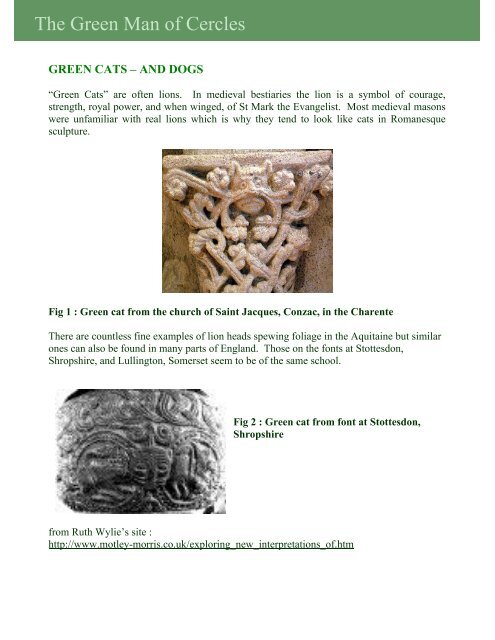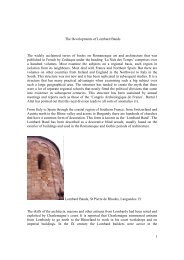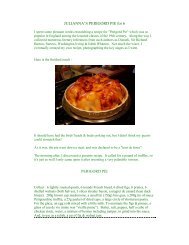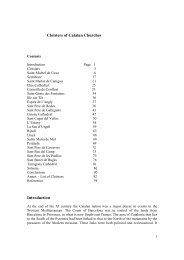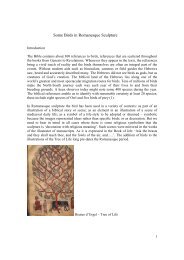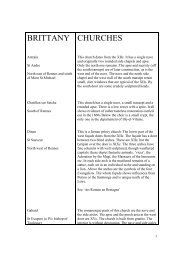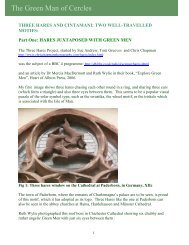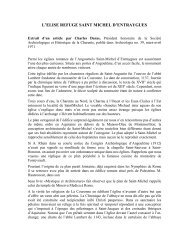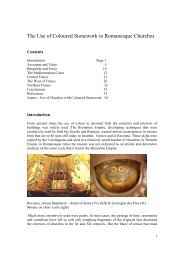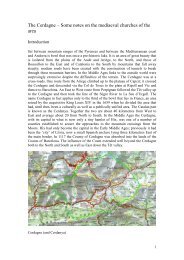click on the link to read this article (pdf) - The Green Man of Cercles
click on the link to read this article (pdf) - The Green Man of Cercles
click on the link to read this article (pdf) - The Green Man of Cercles
You also want an ePaper? Increase the reach of your titles
YUMPU automatically turns print PDFs into web optimized ePapers that Google loves.
<strong>The</strong> <strong>Green</strong> <strong>Man</strong> <strong>of</strong> <strong>Cercles</strong><br />
GREEN CATS – AND DOGS<br />
“<strong>Green</strong> Cats” are <strong>of</strong>ten li<strong>on</strong>s. In medieval bestiaries <strong>the</strong> li<strong>on</strong> is a symbol <strong>of</strong> courage,<br />
strength, royal power, and when winged, <strong>of</strong> St Mark <strong>the</strong> Evangelist. Most medieval mas<strong>on</strong>s<br />
were unfamiliar with real li<strong>on</strong>s which is why <strong>the</strong>y tend <strong>to</strong> look like cats in Romanesque<br />
sculpture.<br />
Fig 1 : <strong>Green</strong> cat from <strong>the</strong> church <strong>of</strong> Saint Jacques, C<strong>on</strong>zac, in <strong>the</strong> Charente<br />
<strong>The</strong>re are countless fine examples <strong>of</strong> li<strong>on</strong> heads spewing foliage in <strong>the</strong> Aquitaine but similar<br />
<strong>on</strong>es can also be found in many parts <strong>of</strong> England. Those <strong>on</strong> <strong>the</strong> f<strong>on</strong>ts at S<strong>to</strong>ttesd<strong>on</strong>,<br />
Shropshire, and Lullingt<strong>on</strong>, Somerset seem <strong>to</strong> be <strong>of</strong> <strong>the</strong> same school.<br />
Fig 2 : <strong>Green</strong> cat from f<strong>on</strong>t at S<strong>to</strong>ttesd<strong>on</strong>,<br />
Shropshire<br />
from Ruth Wylie’s site :<br />
http://www.motley-morris.co.uk/exploring_new_interpretati<strong>on</strong>s_<strong>of</strong>.htm
<strong>The</strong> <strong>Green</strong> <strong>Man</strong> <strong>of</strong> <strong>Cercles</strong><br />
Fig 3 : <strong>Green</strong> cat from f<strong>on</strong>t at Lullingt<strong>on</strong><br />
This image is from Anth<strong>on</strong>y Weir’s site,<br />
http://www.bey<strong>on</strong>d-<strong>the</strong>-pale.org.uk/column.htm (3rd picture<br />
down)<br />
Also, those <strong>on</strong> <strong>the</strong> pillar at Shobd<strong>on</strong> Arches, Herefordshire,<br />
which are said <strong>to</strong> be <strong>of</strong> <strong>the</strong> “Kilpeck School”.<br />
Fig 4 : <strong>Green</strong> cats from Shobd<strong>on</strong> Arches<br />
http://www.crsbi.ac.uk/crsbi/shobd<strong>on</strong>/intro.html<br />
How many cat heads can you see in <strong>this</strong> picture<br />
<strong>The</strong> sculp<strong>to</strong>rs <strong>of</strong> <strong>the</strong>se images may have come from <strong>the</strong> Saint<strong>on</strong>ge regi<strong>on</strong> <strong>of</strong> France, with<br />
Norman, Angevin or Aquitaine noblemen or <strong>the</strong>ir descendants.
<strong>The</strong> <strong>Green</strong> <strong>Man</strong> <strong>of</strong> <strong>Cercles</strong><br />
Fig 5 : <strong>Green</strong> beast from ivory crozier<br />
This image comes from <strong>the</strong> catalogue <strong>of</strong><br />
<strong>the</strong> 2005 Romanesque exhibiti<strong>on</strong> at <strong>the</strong><br />
Louvre, Paris : a ra<strong>the</strong>r humanoid <strong>Green</strong><br />
Beast <strong>on</strong> <strong>the</strong> ivory crozier <strong>of</strong> Yves de<br />
Chartres :<br />
mask”.<br />
<strong>The</strong> catalogue describes it as a “le<strong>on</strong>ine<br />
Ano<strong>the</strong>r image from <strong>the</strong> exhibiti<strong>on</strong> is <strong>this</strong> miniature column-swallower from <strong>the</strong> Tau<br />
<strong>of</strong> Coulombs, Bishop <strong>of</strong> Chartres:<br />
Fig 6 : <strong>Green</strong> cat from Tau <strong>of</strong> Coulombs<br />
<strong>The</strong> Tau is made <strong>of</strong> wood. <strong>The</strong> inspirati<strong>on</strong><br />
for it may have come from an illuminated<br />
manuscript like <strong>the</strong> <strong>on</strong>e below. Such<br />
beasts are frequently found embellishing<br />
capital letters like <strong>this</strong> <strong>on</strong>e from <strong>the</strong> St<br />
Augustine psalter <strong>of</strong> Rouen :<br />
Fig 7 : <strong>Green</strong> cat from Rouen psalter<br />
I would have thought <strong>the</strong> "green cat" was<br />
spewing ra<strong>the</strong>r <strong>the</strong>n swallowing, but it's<br />
always difficult <strong>to</strong> tell. I sent <strong>the</strong>se images <strong>to</strong><br />
Anth<strong>on</strong>y Weir , who replied :<br />
"Thanks for <strong>the</strong> picture <strong>of</strong> <strong>the</strong> Tau <strong>of</strong> Coulombes.<br />
Yes I think column-swallowers originated in
<strong>The</strong> <strong>Green</strong> <strong>Man</strong> <strong>of</strong> <strong>Cercles</strong><br />
<strong>Man</strong>uscripts (probably anglo sax<strong>on</strong> <strong>on</strong>es) <strong>the</strong>n perhaps migrated <strong>to</strong> metalwork and <strong>the</strong>n <strong>to</strong><br />
st<strong>on</strong>e. Swallowers and spewers are difficult <strong>to</strong> separate, <strong>of</strong> course, as with "<strong>Green</strong> Men".<br />
More rare than “felines” are illuminated dogs. This pair <strong>of</strong> Jolly <strong>Green</strong> Push-me-pull-you<br />
dogs comes from a picture <strong>of</strong> St Thomas from <strong>the</strong> famous scrip<strong>to</strong>rium <strong>of</strong> St Martial,<br />
Limoges – probable source <strong>of</strong> many sculptural <strong>the</strong>mes in Aquitaine. (fig. 123 in <strong>the</strong><br />
Romanesque catalogue).<br />
If Thomas is known as “Doubting Thomas” perhaps <strong>the</strong> cheerful dogs are re-assuring him<br />
Look at <strong>the</strong> whole picture, as <strong>the</strong>re’s a lot happening :<br />
Fig 8 : <strong>Green</strong> dog from St Thomas MS<br />
<strong>The</strong> Dogs are c<strong>on</strong>nected <strong>to</strong> <strong>the</strong> <strong>Green</strong> Bird, <strong>the</strong> Bird <strong>to</strong><br />
<strong>the</strong> <strong>Green</strong> Fish (as ICTHUS, emblem <strong>of</strong> Christ, <strong>of</strong><br />
course). <strong>The</strong>n <strong>the</strong> fish makes up <strong>the</strong> circuit by attaching<br />
itself <strong>to</strong> <strong>the</strong> Bird’s tail. All are c<strong>on</strong>nected <strong>to</strong> Saint<br />
Thomas by <strong>the</strong> belt <strong>of</strong> his green cloak.<br />
Could <strong>the</strong> source <strong>of</strong> <strong>this</strong> picture <strong>of</strong> dogs and saint derive<br />
from <strong>the</strong> Dog-headed Saint<br />
See Anth<strong>on</strong>y Weir’s <strong>article</strong> <strong>on</strong> http://www.bey<strong>on</strong>d-<strong>the</strong>pale.co.uk/dogsaints.htm<br />
for more about St Chris<strong>to</strong>pher<br />
Cynephorus or Cynocephalus.<br />
John Harding <strong>of</strong> <strong>the</strong> Sheela-na-Gig project sent me <strong>the</strong> next pho<strong>to</strong>graph : <strong>of</strong> <strong>the</strong> tympanum<br />
<strong>of</strong> Llanbadarn church, but he was unable <strong>to</strong> explain its significance. Let me fantasise : <strong>the</strong><br />
object <strong>to</strong> <strong>the</strong> left <strong>of</strong> <strong>the</strong> cat’s head may be a wheel <strong>of</strong> life with a 9-point star <strong>on</strong> it; cats are<br />
said <strong>to</strong> have 9 lives. A Tree <strong>of</strong> Life springs from <strong>the</strong> cat’s head. <strong>The</strong> dogs’ tails are in a<br />
positi<strong>on</strong> which, in heraldry, signifies virility but <strong>the</strong>y end in a fleur-de-lys, emblem <strong>of</strong> <strong>the</strong><br />
French royalty. <strong>The</strong> dogs <strong>the</strong>mselves are positi<strong>on</strong>ed each side <strong>of</strong> <strong>the</strong> cat’s head like bearers<br />
<strong>on</strong> a shield. <strong>The</strong> entire compositi<strong>on</strong> smacks <strong>of</strong> heraldry. <strong>The</strong> implicati<strong>on</strong> <strong>of</strong> <strong>this</strong> <strong>read</strong>ing<br />
would suggest that <strong>the</strong> tympanum is <strong>of</strong> Insular manufacture, <strong>the</strong> cat representing <strong>the</strong> Sax<strong>on</strong>s<br />
and <strong>the</strong> dogs <strong>the</strong> c<strong>on</strong>querors.
<strong>The</strong> <strong>Green</strong> <strong>Man</strong> <strong>of</strong> <strong>Cercles</strong><br />
Fig 9 : <strong>Green</strong> cat and dogs from Llanbadarn Fawr<br />
Ano<strong>the</strong>r possible cat and dog tympanum from <strong>the</strong> British Isles was sent <strong>to</strong> me by Peter<br />
Hubert :<br />
Fig 10: S<strong>to</strong>w L<strong>on</strong>ga, Hunts, Siren <strong>on</strong> tympanum over priest’s door<br />
<strong>The</strong> Siren’s stance reminds me <strong>of</strong> <strong>on</strong>e at St Georges d’Agout (see “A <strong>Green</strong> <strong>Man</strong> Variant”,<br />
fig 29). <strong>The</strong>se may be three sinful creatures in an unholy trinity, reminding <strong>the</strong> priest <strong>of</strong> <strong>the</strong><br />
dangers <strong>of</strong> sin ever-present. But <strong>the</strong> church notes suggest that <strong>the</strong> "cat" might be <strong>the</strong> Agnus<br />
Dei!<br />
Dr John Hunt, in his <strong>article</strong>, “Kilpeck Church: a window <strong>on</strong> medieval ‘mentalité’ ”, quotes<br />
from <strong>The</strong> Bestiary :
<strong>The</strong> <strong>Green</strong> <strong>Man</strong> <strong>of</strong> <strong>Cercles</strong><br />
“… <strong>the</strong> dog, noted for its understanding, was likened <strong>to</strong> priests. As a dog’s t<strong>on</strong>gue heals<br />
wounds, so <strong>to</strong>o are <strong>the</strong> wounds <strong>of</strong> sin cleansed by priests.” In <strong>the</strong> c<strong>on</strong>text <strong>of</strong> a tympanum<br />
over a priest’s door, <strong>this</strong> sounds quite plausible.<br />
Cat and dog sculptures can be seen <strong>on</strong> two capitals at Carennac in Quercy and <strong>on</strong> capitals in<br />
<strong>the</strong> porch <strong>of</strong> <strong>the</strong> Basilica <strong>of</strong> St Seurin, Bordeaux.<br />
I feel justified in suggesting that <strong>the</strong>se are indeed dogs and not li<strong>on</strong>s, because <strong>the</strong> sculp<strong>to</strong>r<br />
carved proper li<strong>on</strong>s <strong>on</strong> ano<strong>the</strong>r capital in <strong>the</strong> same area :<br />
Figs 11-13, capitals from <strong>the</strong> West porch <strong>of</strong> <strong>the</strong> Basilica <strong>of</strong> St Seurin, Bordeaux.
<strong>The</strong> <strong>Green</strong> <strong>Man</strong> <strong>of</strong> <strong>Cercles</strong><br />
Note that all <strong>the</strong> beasts shown here are associated with “<strong>Green</strong>” images, even if <strong>the</strong> rinceaux<br />
emerging from <strong>the</strong> mouth are (in <strong>the</strong> case <strong>of</strong> <strong>the</strong> dogs), <strong>the</strong> dogs’ tails. However <strong>the</strong>re is a<br />
<strong>Green</strong> <strong>Man</strong> <strong>on</strong> <strong>the</strong> Gothic South porch, where <strong>the</strong> greenery is partly pheasants’ tails:<br />
Fig 14, <strong>Green</strong> <strong>Man</strong> and pheasants frieze <strong>on</strong> capital from <strong>the</strong> Basilica <strong>of</strong> St Seurin, Bordeaux:<br />
(To be c<strong>on</strong>tinued)<br />
Julianna Lees – M<strong>on</strong>tagrier 2008<br />
NB – for more pictures from <strong>the</strong> Basilica <strong>of</strong> St Seurin, including <strong>the</strong> early Christian<br />
sarcophagi in <strong>the</strong> crypt, please <str<strong>on</strong>g>click</str<strong>on</strong>g> here :<br />
http://picasaweb.google.com/JuliannaLees/BordeauxStSeurinBasilica


